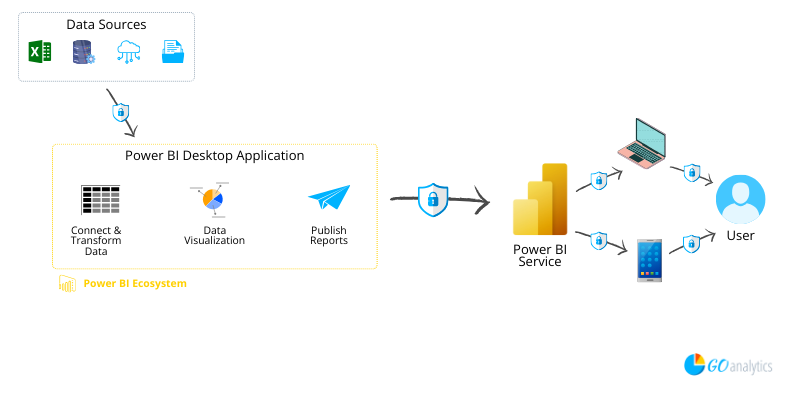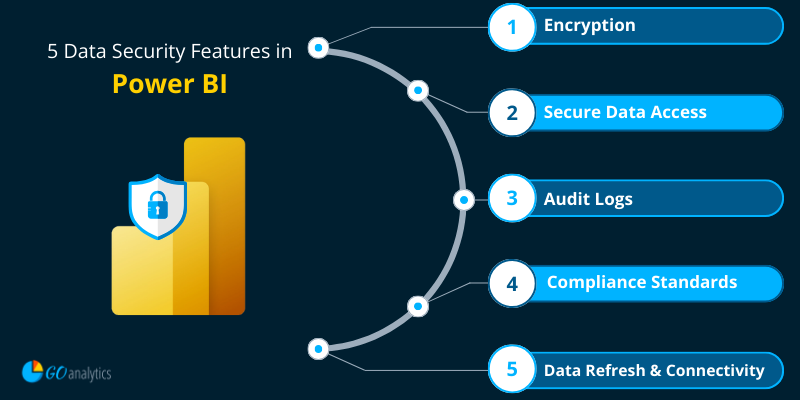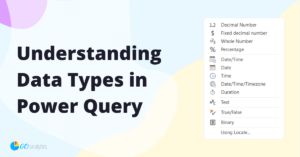In this blog post, we unpack data security in Power BI and answer the question “Is Your Data Safe in Power BI?”.
If your organization is pondering the leap into using Microsoft’s data visualization tool, Power BI, one question that is likely top of mind is about data security. Specifically, you may be questioning whether your data is safe if you are publishing reports to the Power BI Service for sharing and collaboration with your team.
This is a valid concern, especially given the importance of keeping data private and secure. After all, a data breach could cost your organization financial losses, reputational damage, legal troubles, and the loss of trust.
The remainder of this blog post should provide you with some peace of mind as we explore how Microsoft takes significant precautions to ensure every organization’s data is kept private and secure in the Power BI Service.
Understand Power BI and the Power BI Service Model
Before we dive into the nitty-gritty of data security and privacy, let’s quickly review what Power BI is and how the Power BI Service fits into its ecosystem.

As previously described in our blog post “What Is Microsoft Power BI?”, Power BI is not just a software but rather a business intelligence platform that is made up of a suite of analytics tools designed to help organizations analyze data and share insights seamlessly. It allows you to easily connect to a wide variety of data sources, visualize the information in compelling ways, and share those insights with your team or organization.
The Power BI Service – sometimes referred to as Power BI Online – is a cloud-based service that complements the Power BI Desktop application. This is the platform where Power BI reports and dashboards are published, shared, and collaborated on within teams or across an entire organization.
When you connect to your data source in the Power BI Desktop application, data security and privacy is handled via the firewalls and login credentials of your local computer. At this stage, data resides in your computer’s memory, but it has not left the premises. However, when your report is published to the Power BI Service, the data must be transferred and stored in the cloud for consumption by your team or members of your organization. At this stage, data is encrypted and stored in a secure Azure Data Storage.
Data Security in Power BI – A Top Priority
Microsoft, the creators of Power BI, place a high emphasis on security across all its cloud services, including Power BI.
The Power BI Service is governed by the Microsoft Online Services Terms and the Microsoft Enterprise Privacy Statement. The Power BI service follows the Security Development Lifecycle (SDL), and strict security practices that support security assurance and compliance requirements.
Here are the key features and practices that ensure your data remains secure when using the Power BI Service.

Encryption
All data persisted in Power BI Service, both in transit and at rest, is encrypted by default using Microsoft-managed keys. Customer data stored in Azure SQL Databases is fully encrypted using Azure SQL’s Transparent Data Encryption (TDE) technology. Customer data stored in Azure Blob storage is encrypted using Azure Storage Encryption.
When you publish your data to the Power BI Service, it is stored in an Azure Data Storage. Based on your Azure Active Directory Tenant, your data will be stored in the nearest country/region where Azure is deployed. For example, for an organization operating in the Kitchener-Waterloo region of Ontario, the nearest data center is in Toronto, Ontario.
Putting it in simpler terms, whether your data is moving to the Power BI Service (from its original storage) or stored there, it’s protected by strong encryption protocols, making unauthorized access extremely difficult.
Secure Data Access
Accessing analytics solutions in the Power BI Service requires user authentication, which is tied to Azure Active Directory, so you can be sure that only those intended to view the data and reports will have access. Using Role-Level Security (RLS), you can define and control who gets to see what information, adding an extra layer of security. Our Microsoft-certified consulting team can help you keep your data secure and private by defining and implementing appropriate Role-Level Security at your organization. Get in touch with us for an estimate.
Additionally, only users with a Power BI license and who have been granted permission will be able to access any analytics tool. Because Power BI uses a secure authentication, user metadata is captured and can be used for auditing purposes.
Audit Logs
For organizations that require tracking of how data is accessed and used, Power BI provides detailed audit logs. These logs allow administrators to review activities and ensure that data access and usage comply with company policies and regulations.
Compliance Standards
The Power BI Service complies with a wide range of international and industry-specific standards, such as ISO, GDPR, and HIPAA. This compliance ensures that the service adheres to strict guidelines for data protection and privacy.
Data Refresh and Connectivity
When you publish a report to the Power BI Service, you’re not moving your entire database. Instead, you’re sharing a connection to the data or a snapshot, depending on how you set up the report. This means sensitive information can be kept secure, with only necessary data being visualized in the reports.
Once you publish your Power BI reports, you can schedule the refresh of your data, so you always have the latest information. Because all your organization’s data is securely stored and encrypted, Power BI uses an on-premises data gateway to gain access to on-premises data. The gateway serves as a bridge between the online platform and the data that is stored on your secure network. Essentially, the Power BI Service will send an encrypted request to the data gateway, which will decrypt this information and verify the user’s credentials, and then send the information for the query to run.
Best Practices for Ensuring Data Security
While Power BI provides robust security features, ensuring your data is secure and private, your data’s safety also depends on how you and your team use the service.
Here are some best practices to consider.
Manage User Access Carefully
One of the best ways to ensure your data is safe and private is to be deliberate about who has access to what data. While granting everyone access to all the data may be a tempting approach to expedite deployment of Power BI reports, you should consider using the Principle of Least Privilege, which stipulates giving any user only those privileges which are essentially vital to perform intended functions.
Stay Informed on Security Updates
Microsoft is regularly updating Power BI with new features, including security enhancements. It is good practice to stay informed about these updates and how they might affect your data security strategies.
Educate Your Team
Make sure your team is aware of the best practices for data security. This includes understanding the importance of strong passwords, recognizing phishing attempts, and knowing how to securely share data. Our Power BI workshops explore in detail how to securely work with and share data inside of Power BI.
Utilize Service Features
In Power BI, you can use built-in security measures, such as Role-Level Security (RLS), to grant appropriate levels of access to different users or groups.
 Example
Example
While executives working for a chain of auto dealerships might be able to view sales and client data for all dealerships, the manager of Dealership A should only see their sales and clients’ information.
Conclusion
Overall, Microsoft and the Power BI team have gone to great lengths to ensure that your data remains secure. Microsoft takes security very seriously for all its products and services – and Power BI is no different. It meets all the security and compliance requirements at the highest level. As a champion of data protection, Microsoft has been investing in security for years.
By understanding and utilizing the security features provided by Power BI, along with following best practices for data management, you can confidently use the service for your data reporting and analysis needs.
As you embark on your Power BI journey, remember that security is a shared responsibility. Combining Power BI’s robust security features with vigilant data management practices will ensure that your data not only remains secure but also becomes a powerful asset for your team’s collaboration and decision-making processes.
Need Help Implementing Power BI at Your Organization?
Our Microsoft Certified consultants can help


![[How To] Change Data Source Location in Power Query](https://goanalyticsbi.com/wp-content/uploads/2023/07/Change-Source-Data-Location-300x157.png)
![[How To] Enter data directly into Power BI Desktop](https://goanalyticsbi.com/wp-content/uploads/2022/12/Entering-Data-in-Power-BI-300x157.png)
